Martin Edge and Alex Mustard On Underwater Photography
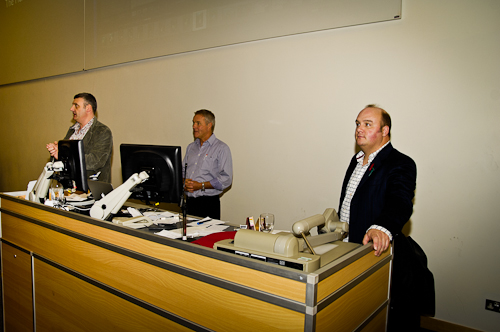
Alex Mustard and Martin Edge played host to over 240 underwater photographers in a packed lecture theatre at Imperial College, London on 6 November. UK equipment suppliers Cameras Underwater organized the event, with tickets on sale via their web site and in their shops. The fact that the turnout was so high is an indications of quite how eagerly awaited the Mustard/Edge combination lecture has been. It attracted photographers from all over the UK as well as visitors from Denmark, Finland, New York and Hawaii. I think that it may be that this is the biggest turnout of underwater photographers for a single event in some time, or possible ever, and it is tribute to both Martin and Alex’s pulling power as speakers, and the level of marketing and organization done by the Cameras Underwater team.
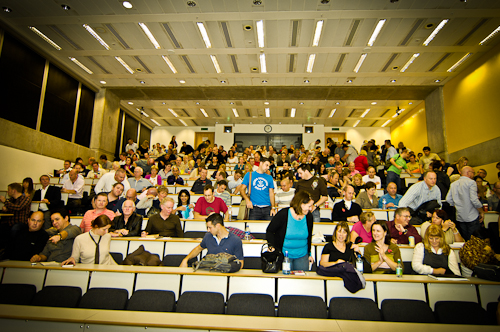
Martin Edge has long been acknowledged not only as a very accomplished photographer, but also as one of those few people who can also show others how he gets the results he does. His books on the subject have long assumed the proportions of standard references. Alex Mustard’s images are no stranger to Wetpixel members, but what is (as yet) relatively unknown is his gift for breaking a successful image down into it’s constituents so that the listener understands the process by which he has achieved the results he does. They both describe themselves as photographers first, and the quality of the images they produce supports this, but they are also gifted educators.
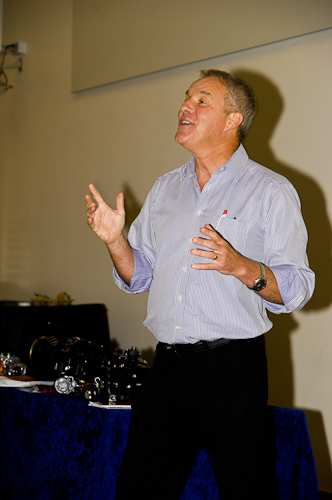
The format for the event was to use a combination of show and tell with each using his own and, eventually the audiences’, images to illustrate techniques or pitfalls. Most of the images used had had little or no post capture treatment, as the unedited images allowed more latitude for discussion into how the image was created. They kicked off with Martin Edge highlighting the difference between a diver with a camera and an underwater photographer.
” Are you a photographer who has to use a tank to get the pictures you want?”
The theme for the following series of lectures was all based on the concept of the background. Alex presented a series of ideas on “tactics against backscatter” and emphasised that the key is to understand what causes the problem:
“Know your enemy.”
Amongst the techniques listed were getting closer to the subject, going one lens wider, increasing ISO, using more available light and to frame the subject tightly. Each technique was illustrated by examples from Alex’s portfolio of how it worked (or didn’t). Closing his section on backscatter, Alex mentioned the use of snoots and off-camera flash as tools for difficult conditions, quite apart from their creative applications.
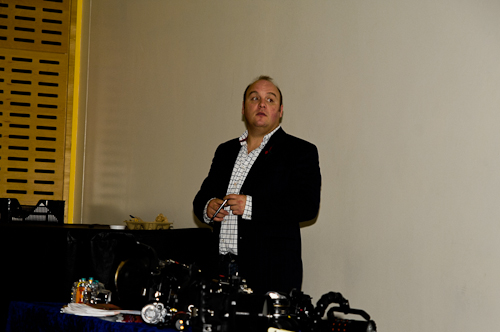
Martin then picked up, moving on specifically to evaluate the value and techniques of shooting backgrounds. He argued and illustrated that the background is more important than the subject in many cases, and that photographers should seek out good backgrounds and then allow or find subjects for them, rather than vica versa. He emphasised the importance of a divers body position and found out by show of hands that less than half of the audience consider their body position when taking a shot! During a recent trip with Martin, photographer Keith Lyall had been videoed by Jo Horricks whilst shooting, and he was able to use the video and the images produced to great effect in illustrating specific techniques. Both he and Alex are well known exponents of using blue water as a background, and hence it was no surprise that they both devoted some time to explaining how to achieve this.
Whilst Martin’s section had a slight bias towards macro photography, Alex’s part two was all about wide-angle backgrounds. He identified that the key mistake made was not to put enough light onto the subject, which causes the color of the background to be lost. He spoke about the creative use of shooting with and against the light, sunbursts, surface textures and dappled evening light and it’s effect:
“Find beautiful light and put anything in front of it and it will look great!”
Before breaking for lunch, they both requested attendees to supply questions that they would like the pair to cover, and also images that they would like to be evaluated. Cameras Underwater had a display of camera equipment, and inevitably, the break allowed people to view and fondle the items on display.
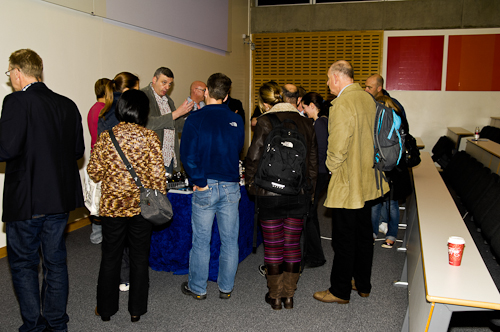
Kicking off after lunch was a series of question and answer sessions. It was interesting to see how well the pair were able to predict these, as they had pre-prepared presentations that covered many of the topics. Snoots were covered in more depth, with Alex emphasising that perhaps really creative and original use of these does come from familiarity with them. Once again, Martin had video illustrations of snooting:
“Sometimes what makes a photo sing is not so much where the light is; but where it isn’t.”
The pair then fielded questions on the debate about torch vs. strobe, and whether deliberate over exposure is acceptable creatively. Martin showed how the vignette tool in Lightroom 3 could be used to provide creative effects, in this case with a (technically) overexposed image. “Motion in the ocean” and the deliberate use of motion blur followed, with Martin emphasizing that in order to be creative, you need to;
“practise and make plenty of space for some “play time.”“
Inward lighting, another tool in which the photographer points the strobes almost back at him or herself (“you have to remember to close your eyes”) is another tool to eliminate distracting backgrounds for both macro and wide-angle photography. Lastly, Alex provided illustrated pointers on split level shots.
The event finished with the pair showing and telling what is exciting them in underwater photography right now, and a review of images supplied by the audience.
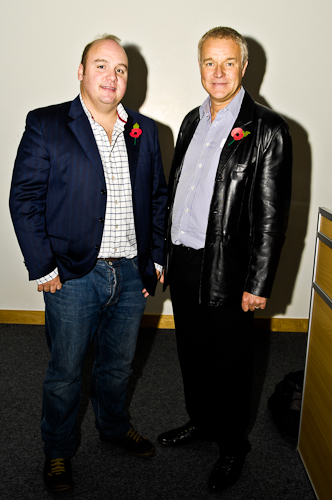
The number of people attending this event and the excitement it has caused should provide valuable feedback to its value. There is talk about a Mustard/Edge roadshow (although I gather no plans have been made) and if it comes to a town near you I would urge you to attend. The insight, and above all the communication of their ideas is nothing short of inspirational. Although aimed at dedicated underwater photographers, the information is presented in down to earth language and aimed at as broad a cross-section of attendees as possible. I think that this type of presentation would lend itself to an elearning/podcast format and it would be great to see this type of program going out to a wider audience.
I leave the last words to Marten Bjorn Larsen and Peter Kaiser, who had both flown in from Denmark for the day specifically to attend the event:
“We have never been in an environment where there is so much experience being freely shared.” And “it is worth travelling far for something so good!”
Thanks to Cameras Underwater who provided me with a press pass to attend the event.